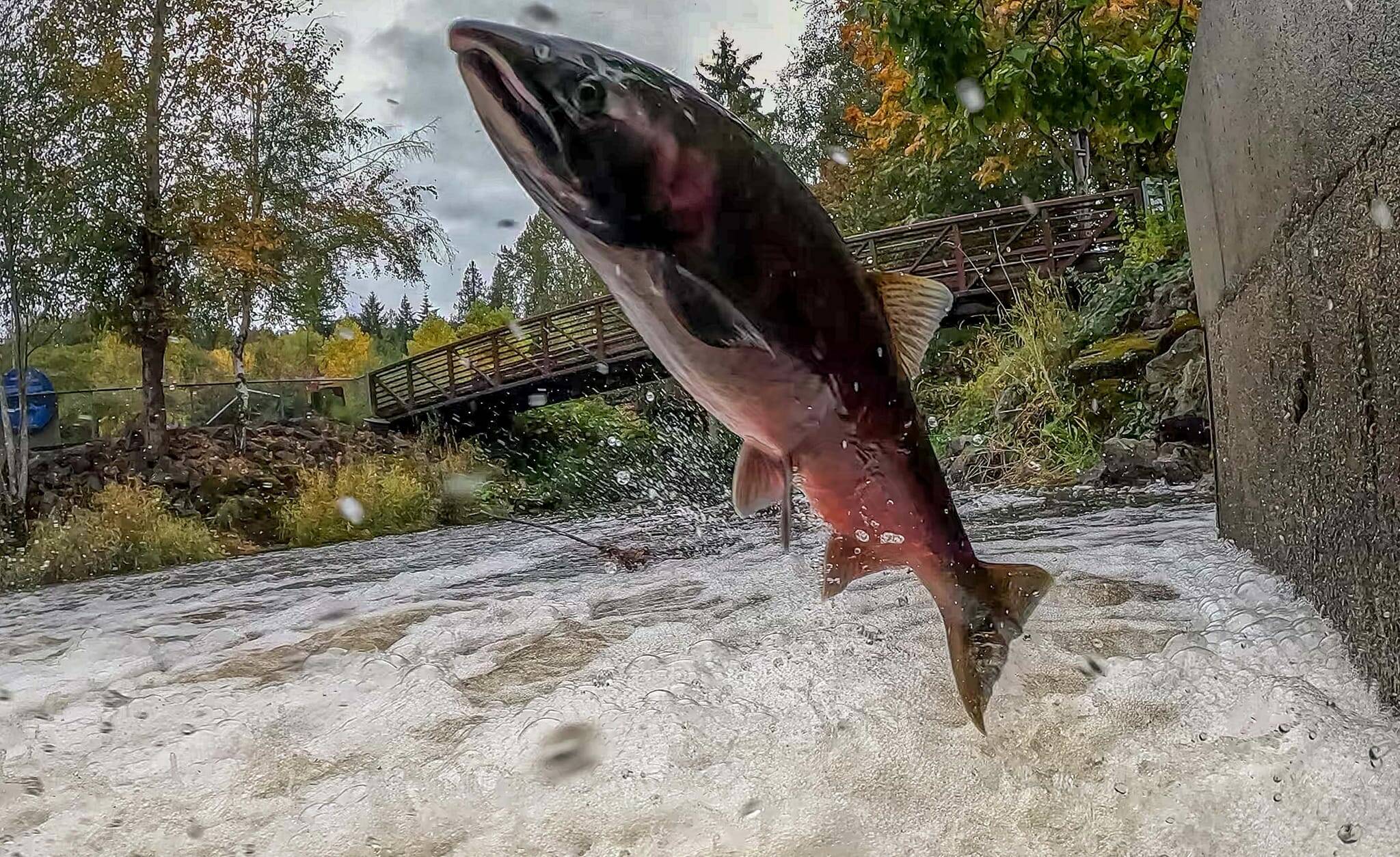Standing on a concrete bridge in downtown Issaquah, the cold worked its way up from the soles of my feet to my legs, and onwards. Drops of rain clouded my eyeglasses. I struggled to balance an umbrella and hold my cellphone steady as I waited, fearing my fingers would freeze. My mission: photograph a Coho salmon approaching its final hurdle before returning “home” to the salmon hatchery. It was early November, slightly past the height of the salmon run. But two mergansers, bobbing their cinnamon-rust-colored heads as they circled the water, offered a clue that fish were still coming. They were awaiting a feast.
A sudden flash of crimson/orange below the churning water meant a male Coho was about to jump! I was ready for the beauty shot. Arching its long, red body into a spiral, it leapt. And… it was gone. In a second, the three-year-old was out of sight, swimming his way to the Issaquah Hatchery after eighteen months at sea. Its piscine Rumspringa over, he was home for the holidays, ready to spawn. I missed my chance to capture the image. But now I could get off that cold bridge, start moving, and warm myself up.
Washington’s Department of Fish and Wildlife (WDFW) has hatcheries all around the state, and visiting is free. They raise sixteen different species: Steelhead, Rainbow, and Cutthroat Trout, and salmon varieties including Chinook, Chum, Coho, Pink, Sockeye, and Kokanee. An adult Coho can weigh up to twenty-five pounds, though most average eight. Some spend their entire lives in Puget Sound, others migrate to the ocean.
In a dynamic collaboration between WDFW and the Muckleshoot Tribe, thousands of adult, pre-spawn salmon were released in upstream locations, ensuring future “home-runs” in multiple water bodies. Hiking in Coal Creek, you’ll see them navigating the narrow streams along the trails. More formal viewing opportunities include the Salmon Days festival in Issaquah, the Hiram M. Chittenden Locks, Cedar River in Renton, and Lake Sammamish State Park in Issaquah. Kelsey Creek in Bellevue even has a webcam providing real-time views of salmon activity.
To see a colorful school of thirty-three salmon, visit the Seattle Aquarium’s brand-spanking new Ocean Pavilion. At the entrance, an installation by Lummi Nation glass artist Dan Friday makes you feel as if you’re walking just below the water’s surface. Above you, life-sized, multi-colored salmon follow your climb up a ramp leading to where entry-tickets are scanned. One, reportedly the hardest to make, is the same crimson color as my Issaquah Coho. But hold on – the salmon are supposed to be swimming towards the main hall of the pavilion. Big oopsie – they were installed facing the wrong way! The glass fish appear to be swimming down, towards the entrance and exit doors. I guess it’s too expensive to correct that mistake.
Speaking of expensive ($45 for adults), entry to the aquarium is pricey, even with a Washington State resident discount ($40, minus $2 for seniors, military, and tribal members). But there’s a way to enjoy the Ocean Pavilion without aquarium admission. Stand outside the building, below the cantilevered Oculus, and watch sea life swimming above you. It’s mesmerizing. And
totally free. You can also walk inside to admire the glass fish in the entryway without ascending the ramp.
If you splurge for tickets, be prepared to experience awe. “Oh my God,” I gasped when I got to The Reef, the interior side of the Oculus. Sitting on a bench facing the tall glass wall, I watched the action. A Whip-tailed Ray, 12’ long from nose to tail, Guitar Fish, Spotted Eagle Rays, and all the other fish I’d seen outside swam around the enormous tank. It was hard to tear away, but I wanted to explore more of the new Waterfront Park, a major project connecting Seattle’s “waterfront to market-front,” Pike Market.
Sitting on 20 acres, this new public space, where the Alaskan Way Viaduct once separated Elliott Bay from the city above it, stretches from the Stadium District to Belltown. The park’s open vista is a huge upgrade for Seattle, rivaling New York City’s Highline, and acclaimed international water-hugging promenades like Tel Aviv’s Tayelet and Stockholm’s Norr Mälarstrand.
The architecture, landscaping, children’s playgrounds, and graceful curves make this a most inviting space – graffiti-free up until now, thanks to the same group that patrols Seattle Center. On my way up the stairs, I stopped to visit the artists’ residences, following signs that said “Open.” Michael J Staum, whose hand-sculpted leather is sold in Pike Market, occupies one of seven live-in/work-sell studios for artists over age 55. For him, scoring this apartment was a “golden ticket that keeps getting bigger.”
With first-class attractions for all to enjoy, Seattle’s new Waterfront Park is the jewel in its crown.
Meanderings is a travel column by Mindy Stern, a Mercer Island resident whose essays can be found at www.mindysternauthor.com.



